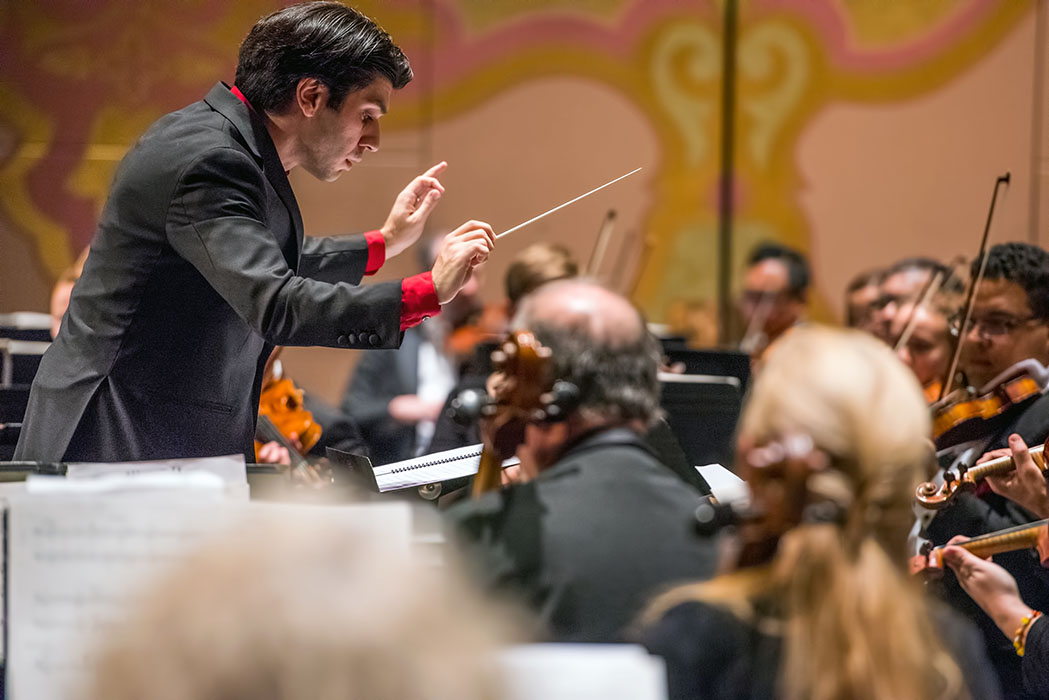It was an evening of dance for the Knoxville Symphony Orchestra last weekend, but that statement requires a bit of explanation.
Much like the rhythm of a waltz, concert hall interest in music from Peter Ilyich Tchaikovsky’s ballets has had its ups and downs over the years. Without the visual interest of the actual ballet, contemporary audiences and orchestras have often considered the music a bit too light and unsubstantial to hold one’s attention for long. However, judging from the overwhelming audience reaction to last weekend’s performance by the KSO under conductor Aram Demirjian of a suite of music from the ballet Swan Lake, perhaps it was truly time for a re-visit. To be sure, Tchaikovsky’s gift for creating addictive melodies explains why it wasn’t surprising to hear members of the audience leaving the Tennessee Theatre humming and whistling the “tunes.” For those poor souls still haunted by Odette’s leitmotiv or by the waltz melody still swimming through their head, I fully understand—and empathize.
The famous and wistful oboe theme from the Act II Scene mentioned above was handled with a gorgeous spaciousness of tone and nuance by principal Claire Chenette. Concertmaster William Shaub, in an evening of notable work, gave the violin solos a superb sculpted edge that radiated with intriguing details. Grabbing some of the spotlight was a golden lyrical tone from principal cello Andy Bryenton and some equally enchanting harp arpeggios from principal Cindy Hicks. The violin section as a whole played with an impressive unity of purpose in those grand sweeping gestures of lyricism that so describe Tchaikovsky’s music for dance. Of paramount importance to the willing acceptance of non-visualized ballet music was Demirjian’s energetic, but varied pacing and dynamics that provided just the right touch of theatrics and dramatic emphasis.
But, the theme for the evening was “Timeless Romance: Swan Lake and More.” While the music of Swan Lake had to manage its intrigues without the benefits of physical dance, the “more” came courtesy of the preceding work, the 1924 ballet version of El amor brujo (“Love, the Magician”) by Manuel De Falla. Performed with partially staged choreography from Amy Morton Vaughn and dancers from the Appalachian Ballet Company, the De Falla was quite the centerpiece. Although performing on the apron of the Tennessee Theatre stage in front of Demirjian and the orchestra—sans scenery or dramatic lighting—the result from the ABC principal character soloists and corps was, nonetheless, mesmerizing as storytelling, and deliciously impressive as individual performances—and as ensemble ballet.
The story of El amor brujo surrounds a young woman haunted by the ghost of her dead husband who is preventing her from loving another. A plan is arranged between the new lovers whereby a gypsy girl, Lucia, will distract the ghost from his interference with a seduction of her own. Thus distracted, the spell is broken and the ghost is vanquished.
Dancing the role of Candelas, the beautiful young woman, was Kylie Morton Berry; her handsome lover, Carmelo, was David Ward. The Ghost, appropriately made-up in gray, was danced colorfully by Peyton Andersen; dancing the role of the hot-blooded Lucia was Arbor Phillips. For those yearning for more dance and ballet on Knoxville stages, ABC’s contribution was an all too welcome event.
The score’s mezzo-soprano voice role, something of a commenter on the sensual context of the story, was sung with a tantalizing earthiness by Solange Merdinian. Demirjian and the orchestra kept the pacing brisk and the music side of the story colorfully descriptive. There were some marvelously notable, even thrilling, solo jaunts within De Falla’s musical narrative—all brimming with color, attitude, and instrumental effect—from the orchestra’s usual suspects: principal trumpet Phillip Chase Hawkins, oboist Chenette, concertmaster Shaub, cellist Bryenton, and principal horn Jeffery Whaley.
Opening the concert was an instrumental interlude from Frederick Delius’s 1910 opera A Village Romeo and Juliet: “The Walk to the Paradise Garden”. While the opera itself is rarely performed, the interlude that bridges scene 5 and 6 has drawn attention for its evocative, ethereal quality that vaguely hints at an early 20th Century pre-jazz idiom, notably by juxtaposing the oboe and English horn for an effect of reflection and poignance. The KSO’s performance was—dare I say it—heavenly.







